Spirit Vessels—Information
Spirit Vessels are ceramic urns and containers designed to preserve the ashes of lost loved ones. Rather than casting the ashes to the wind, land, or sea, they are a memorial to remember and honor the deceased.
What is important to us as a species? Well, some of the big ones are love, family, home, work, and death with the home around which the others revolve. The home is also the glue for family ties as well as a place to come back to. Death and consideration of a spiritual afterlife is another. It raises questions about the disposition of the physical remains, and just how family members wish to remember the lost family member.
Historically much of ancient civilizations has been learned through the preservation of the dead and their memorial sites. The subject brings to mind mummies entombed in the pyramids of Egypt, bones stacked in the catacombs of Europe, stone coffins of knights, kings, and saints housed in the floors of cathedrals, wooden coffins and graveyard headstones and markers, stone cairns, dirt mounds and wooden trellises of Native American Indians and the ceramic funerary urns of all the peoples of the world.
The container becomes the physical home for the deceased's ashes and some believe, the spirit. Certain Native American Indian tribes believed that the spirit could be captured and stolen by cameras and refused to allow their pictures to be taken. Some buried their dead with ceramic bowls over the head, but punched a hole to ensure the spirit would not be trapped within the vessel. The vessel was then a home from which the spirit could roam. This brings me to design concepts for Spirit Vessels.
Spirit Vessel Concepts and Origins
While studying ceramics as a student I encountered a picture of a jug from ancient Crete
embellished with a painting of an octopus. The octopus looked me straight in the eye, and
I had an epiphany. Art for me was to be about Concept. We all have seen fish bowls. Because
the container is made of glass we can see the fish and the environment within.
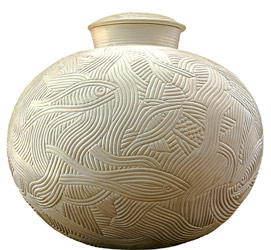
Just so, the artist who painted the octopus upon the outside of the ceramic jug must have visualized an octopus looking at him through a glass wall as in an aquarium. The jug was the home of the octopus and the Mediterranean Sea. Understanding this simple concept helped me over the years to understand surface design and how to relate it to the forms I built. I came to realize it wasn't just about surface design, but about expressing home and the spirit that resided within.
People differ the world over in their beliefs and this is often reflected in their homes.
Even though different environments decide much of the basic appearances of homes—a forest
home built of wood, tents in the desert, an igloo of ice—the home can also reflect the
individual personalities of its residents. A favorite story series of mine followed Dorothy
and her companions, the Tin Man, the Scarecrow, and the Cowardly Lion, in their travels
through the world of Oz. One story described Dorothy and her friends passing through
a village in which the outside of all the houses were beautiful, but the insides shabby
and unkempt. In a second village the houses were uninviting on the outside, but warm
and friendly on the inside. This story shows how different people build homes
that create projections of themselves.
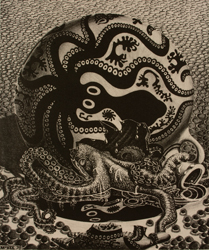
Returning to the octopus jug, I would like to further share my understanding of another artist's concept. While printmaking, I made a lithographic drawing in 1978 utilizing the image of the octopus jug. Inside Out showed the jug dropped on cobblestones, freeing the octopus spirit within.
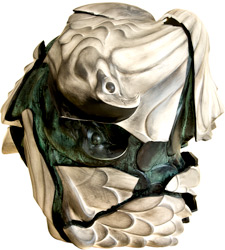
Other fabled dwellers of jars and magic lamps were Genies. But of course they were trapped within the containers by magicians, existing as slaves and only freed at their owners' commands. Could this be why the Native American Indian Mimbres knocked holes in their burial ceramics? To make sure the spirit was not trapped?
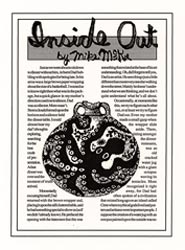
Another example of the concept is a short story I wrote in 1988 to share these ideas and their special meanings with my daughter. The story, like the lithograph, was called Inside Out, and utilized the same concepts of a broken pot, home and spirit. Go to story
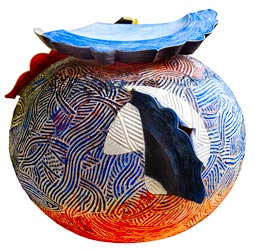
The spirit vessel Apple Pie is another example of a concept important to my art and one discovered accidentally while completing a construction job.
In 1980 my family came to Santa Cruz and purchased a painted lady (1890's Victorian house) in very rundown condition with moldings, soffits, gables, posts, large window casings, corbels, first and second story floor line drip projections. When it came time to paint it, I did not like the threatening feeling of the front porch enveloped in shadow as it was. Seeking to remedy the gloom, I painted the ceiling of the porch a very light color. The brightness illuminated it, creating a warm and friendly entry for family and friends. By reversing the natural order of light and painting the undersides a bright color I had solved the problem. Apple Pie uses this concept illuminating what would naturally be dark areas.
I have attempted with these few examples to illustrate the power of concepts. Even the titles I have selected for the Spirit Vessels are designed to illustrate. Looking Glass is clearly a glass fish bowl, Avatar a freed spirit, Apple Pie a sample of illumination and warmth. To me art is not meant to be difficult to understand. Once the concept behind it is grasped, it is easily shared and enjoyed. Art and nature are much the same. It is right before our eyes if we only look and participate. But when all is said, I hope none of my words or titles preclude the viewer from having their own personal epiphany through Spirit Vessels.
In the end I made these vessels out of the need to create art. But like so many similar vessels that came before, they are meant to remind one of the individual personality of the deceased as well as a special memorial for future generations, reminding them of someone special. We as a species have a need to honor our dead, remember their character, and house their remains. We also need to allow for a continuing spirit that needs both, family, loved ones and home close together, and freedom to wander.